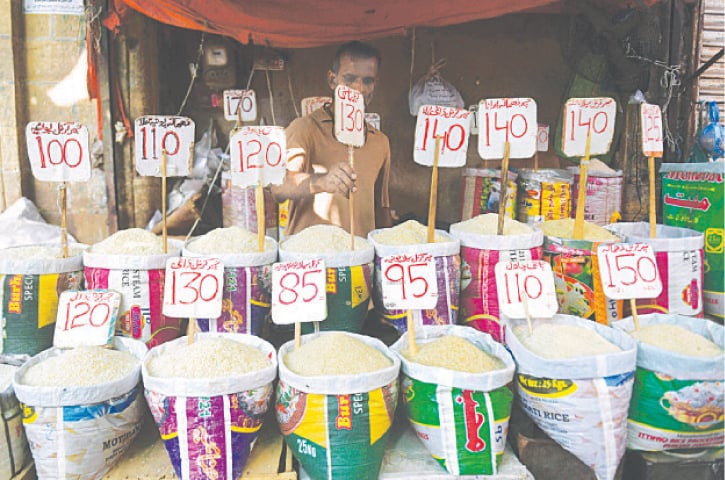
KARACHI: Amid high food prices of various items, including wheat flour, sugar, ghee, cooking oil, loose milk, chicken, veal and mutton, vegetables, etc, the Economic Survey 2020-2021 says “the headline inflation measured by the Consumer Price Index (CPI) was recorded at 8.6 per cent during July-April FY2021 as against 11.2pc during the same period last year.”
The survey said that due to the government’s measures for maintaining price stability, inflation in perishable food items increased by 0.1pc as against an exorbitant rise of 34.7pc during the same period last year.
Non-perishable food items are the main contributory factor to jacking up food inflation in the food and non-alcoholic beverages group, as it is recorded at 16pc against the increase of 12.4pc during the same period last year. Among the non-perishable food items, the upward pressure came from the poultry group (chicken and eggs), followed by the staple group (wheat, wheat flour and edible oil), the survey said.
The increase in the poultry group may be attributed to the viral disease which caused supply-side risks. Wheat prices rose by more than 24pc in April 2021 over April 2020 due to supply disruption. However, there was a decrease of 9pc over March 2021 mainly due to the government efforts for smooth supply of wheat.
Govt measures to curb price hike credited for the relief
One of the measures was timely release of wheat in the provinces by the procurement agencies and provision of the commodity via the utility stores and fair price outlets which managed to ease price pressures.
The prices of edible oil, palm oil and soybean have been on a steep rise in the international market since June 2020, amid sharp contractions in global inventory levels due to weather-related concerns in the major producing areas.
The housing, water, electricity, gas and other fuels have recorded an increase of 5.7pc during July-April FY2021 as against 7.1pc during the same period last year. It has a weight of 23.6pc, thus any untoward movement directly affects the vulnerable segments of society.
In Q1 FY2021, although CPI was brought to a single digit, 8.85pc, from 10.08pc in the corresponding quarter last year, however, it was noted that inflation remained high on account of an increase in prices of food items, mainly non-perishable ones.
In Q2 FY2021, again it was noticed that the main driver in CPI remained food items mainly due to price differential in food items among provinces. The major reason could be a high province-wise margin between wholesalers and retailers.
In Q3 FY2021, the government effort for maintaining a smooth supply of food items, both perishable and non-perishable, helped in containing inflation to 7.8pc compared to 12.38pc in the corresponding quarter last fiscal year. However, prices of restaurant and hotels, clothing and footwear, housing, water, electricity, gas and other fuels remained relatively higher due to economic recovery.
During July-April FY2021, CPI-Urban was recorded at 7.7pc against 10.7pc during the same period last year. During the period, CPI-Rural was recorded at 10pc against 12pc during the same period last year.
Loose price checks in rural areas
The inflation differential in rural and urban areas may be attributed to relatively loose price checks in rural areas. However, food inflation in rural areas was lower than in urban areas because agriculture products related to food are produced in rural areas. The high non-food inflation in rural areas can be attributed to the transport cost.
The core inflation for urban and rural areas was recorded at 5.8pc and 7.6pc, respectively, during July-April FY2021 as compared to 7.8pc and 8.7pc during the same period last year.
Govt measures to combat inflation
On the way forward, the government is making efforts to bring down inflation by ensuring smooth supply of commodities, checking profiteering and hoarding and vigilant monitoring of prices both at federal and provincial levels.
In order to maintain the sufficient supply of wheat and sugar in the market, the government intends timely import of wheat and sugar to bridge the demand-supply gap.
The government is also taking measures to provide incentives to farmers for increasing agriculture production. In this regard, the government has already approved a subsidy disbursement of Rs19.2 billion for Kharif 2021 through provinces on a sharing basis (75:25) for agriculture inputs.
The government has also focused on a medium- and long-term strategy for raising production of essential imported food items, mainly edible oil and pulses. Thus, with these measures associated risks of price hike will be mitigated, the survey added.
According to figures of the Pakistan Bureau of Statistics, Pakistan had imported 3.6 million tonnes of wheat during July-April 2020-2021, costing $983 million, while sugar imports reached 280,377 tonnes, valuing $127m. But consumers continued to pay high prices of these two main commodities.
From July to April 2020-2021, consumers had braved Rs320-330 per kg/litre in ghee and cooking oil prices, which was Rs250 per kg/litre in August 2020.
Sugar price soared to Rs110 per kg in March 2021, while in February 2021, fresh milk and yogurt prices were raised to Rs130 per kg and Rs200 per kg from Rs120 and Rs180 per kg, respectively.
December 2020 recorded the highest-ever peak of Rs200-240 per dozen in eggs, while ginger rate swelled to Rs600-700 per kg in October 2020 followed by up to Rs200 per kg in tomato and Rs80 per kg in onion.
In March 2021, veal meat with and without bones prices rose to Rs630-650 per kg and Rs730-750 per kg while mutton prices were raised to Rs1,300 from Rs1,200 per kg. Currently, veal meat with and without bones sells at Rs700-750 and Rs800-850 per kg, while mutton prices hover from Rs1,300-1,500 per kg depending on the areas.
In July 2020, flour No 2.5 was available at Rs48 per kg as compared to Rs61.50 per kg now.
Chicken prices have now crashed to Rs200-230 per kg for live bird and Rs300-360 per kg for its meat after two inquiries against feed producers and poultry producers by the Competition Commission of Pakistan from its peak of Rs350-360 per kg for live bird and Rs520-640 for its meat without giblets recorded in May.
Published in Dawn, June 11th, 2021














































